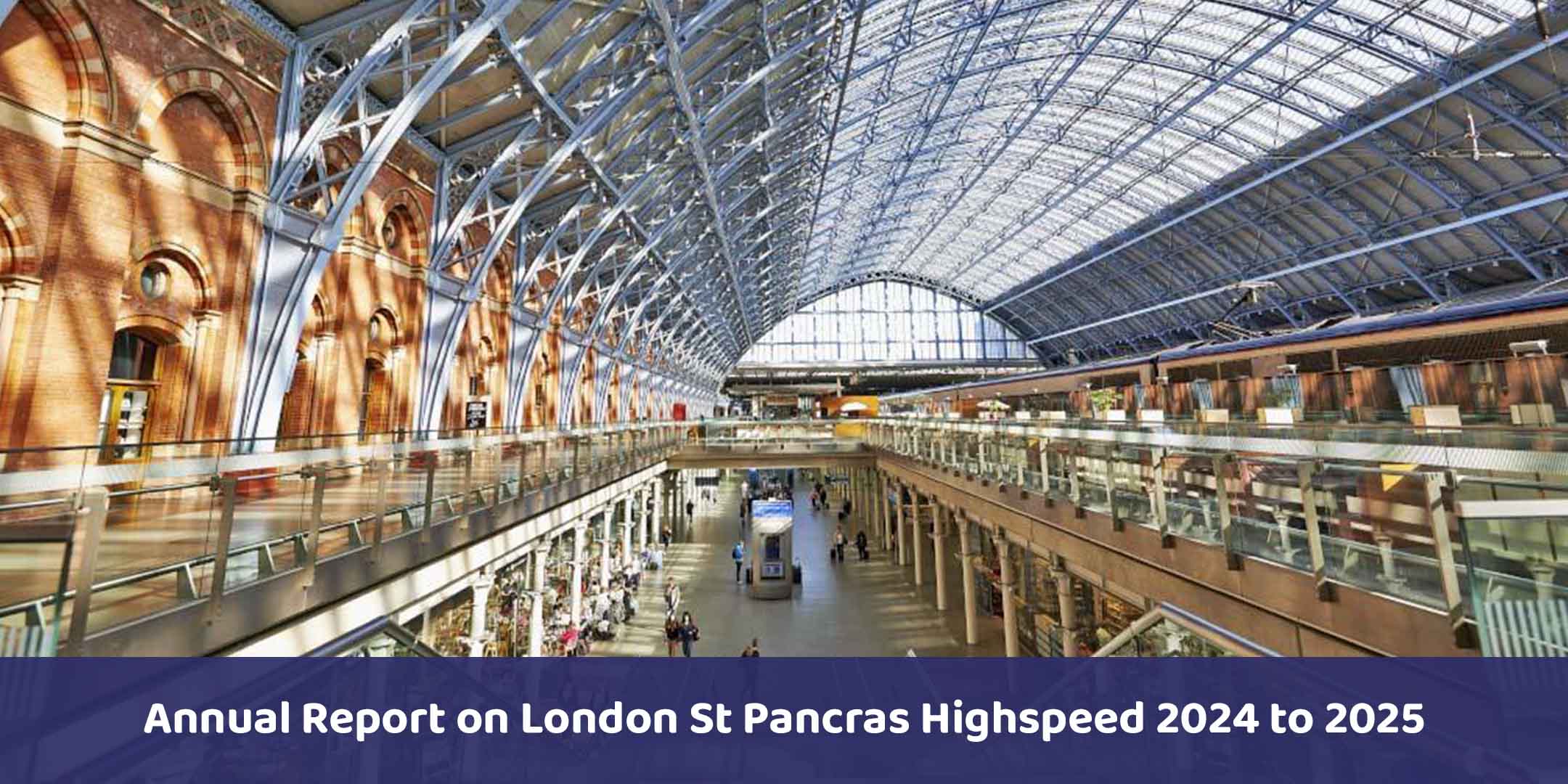Covering the period from 1 April 2024 to 31 March 2025

Executive summary
This report sets out our assessment of the regulated aspects of London St. Pancras Highspeed’s operational and financial performance for the financial year 1 April 2024 to 31 March 2025, which was the final year of Control Period 3 (CP3, which ran from 1 April 2020 to 31 March 2025). More information on our regulation of London St. Pancras Highspeed, including previous years’ reports, can be accessed on our website.
We report here on our assessment of the company’s delivery against the final determination and decisions of our and the Department for Transport’s (DfT’s) periodic reviews of London St. Pancras Highspeed (then named HS1 Ltd) 2019 respectively (PR19s), in accordance with our policies for holding London St. Pancras Highspeed to account in CP3 for the route and stations. More information on PR19 can be found on our website. We published the final determination of our latest periodic review of London St. Pancras Highspeed, PR24, on 6 January 2025.
The key issues over the last year were:
Health and Safety
The HS1 network has historically seen relatively low levels of incidents and accidents involving members of the public and the workforce and continues to achieve a level of safety performance above other GB infrastructure managers, potentially reflecting the relatively modern nature of the infrastructure. There were no fatalities or serious injuries during the reporting year. However, workforce and public safety performance climbed above the moving annual average threshold set by London St. Pancras Highspeed for both workforce and public fatalities and weighted serious injuries. This trend is not acceptable and required attention from London St. Pancras Highspeed, but we have examined the root causes and concluded the following:
- in relation to the workforce, an increase in contractor injuries from 59 in the previous year, to 78 this year, was primarily due to external factors, notably: physical assaults to customer-facing staff in stations; and a road traffic collision (caused by a third party) involving three members of NR(HS) staff which led to significant lost-time injuries. We have seen satisfactory evidence that London St. Pancras Highspeed and NR(HS) had reasonable risk assessments and mitigations; and that they have now undertaken work with contractors and stakeholders to address root causes and improve their mitigations, going forwards; and
- in relation to the risks to the public - an escalator malfunction at Ebbsfleet International Station in November 2024 led to two members of the public attending hospital. We have seen evidence that London St. Pancras Highspeed has taken actions, including commissioning multiple reviews following the incident (by NR(HS), its maintenance contractor and an independent body) and that recommendations are being acted on.
However, we consider that the root cause of this incident relates to a lack of asset management maturity. Within this reporting year, we took action on this lack of maturity through the PR24 process, by determining that London St. Pancras Highspeed needed to accelerate improvements to its asset management of lifts and escalators. Lifts and escalators are of particular concern to us and to stakeholders, because they have a direct impact on passengers, especially those with accessibility needs. Since our Final Determination (6 January 2025) we have seen evidence of London St. Pancras Highspeed prioritising improvements in this area. We will continue to monitor this closely in Year 1 of CP4 and, if the PR24 commitments are not being achieved, we will need to consider escalation through our enforcement policy.
Traffic volume and train service performance
Traffic volume on the HS1 route increased by around 8% in the period 1 April 2024 to 31 March 2025 compared to the previous year.
The number of services delayed by London St. Pancras Highspeed-attributable incidents during the year was 169 (0.26% of all services using the network), markedly better than the previous year’s proportion of 0.76%, and substantially better than the maximum allowed in its Concession Agreement (13%).
This year, we saw a reduction in significant route asset incidents i.e. those causing a delay of 200 minutes or more. This year had an average delay of 4.2s per train, well down on the almost 12s per train the year before. London St. Pancras Highspeed has made good progress in addressing ‘repeat failures’, notably points failures.
Performance on the network is now becoming dominated by low likelihood, high impact events, where there are challenges around operational recovery. Significant incidents this year included a major points failure and two trespass incidents (trespass has historically been a key issue on HS1) as well as two external power supply interruptions.
Asset Management
This report highlights the need for improved asset management maturity across several asset groups, covering both route and station assets. There have been some positive changes in the last year, for example the company introduced a new Enterprise Asset Management System and implemented learnings from the previous year’s significant flooding incident in the Thames Tunnel.
Our report supports the direction the company is taking but seeks to highlight areas that require further work. In particular:
- predictive asset monitoring, i.e. using data to predict when assets will fail for the first time, rather than relying on designers’ estimates, or reacting to failures; and
- future resilience, including climate change (mainly flooding and heat), but also understanding obsolescence and risks from software and licensing.
During the reporting year, we broadly supported London St. Pancras Highspeed’s changes to the governance of its renewals portfolios, including aligning planning to optimise possessions access. The company delivered 28 of its 39 renewals milestones. We are satisfied that the right decisions were made to defer the remaining milestones, based on remaining asset life or efficient delivery. London St. Pancras Highspeed overspent on renewals on both the route (by 24%) and stations (by 42%) in the reporting year, primarily due to the acceleration of large works from the next control period, taking opportunities for efficiency.
Finance and efficiency
The network continued to recover from the effects of the COVID-19 pandemic this year, with London St. Pancras Highspeed receiving £111.5m of income this reporting year, £12.1m higher than assumed in our PR19 forecast. This included £7.4m higher recovery on international services, £4.6m higher recovery on domestic passenger services following charging reopeners to reflect actual traffic volumes; and £0.1m of higher recovery costs for freight services.
In terms of spending, London St. Pancras Highspeed spent £99.2m operating and maintaining its rail infrastructure, £1.4m higher than assumed at PR19. London St. Pancras Highspeed’s own costs were £1.3m higher than assumed at PR19, which the company has attributed to additional work on PR24.
Network Rail (High Speed) Ltd (NR(HS)), the company that manages the infrastructure, reported £4m of net efficiency improvements against PR19 efficiency target of £3.4m (2024-25 prices) for the year 1 April 2024 to 31 March 2025. These savings include staff-related savings, which results from the implementation of a new target operating model by NR(HS). Offsetting these are headwinds such as a £0.5m increase related to additional weld repairs on the route.
NR(HS) has outperformed on its core efficiency commitments for CP3 and reported net efficiency savings of £17m against PR19 CP3 target of £11m (2024-25 prices).
Background
HS1 Ltd (trading as London St. Pancras Highspeed from this year) has a 30-year Concession Agreement from the Secretary of State for Transport to operate and manage the HS1 route, and concurrent leases for the four stations on the network.
London St. Pancras Highspeed is responsible for the overall management and operation of the HS1 network. However, it subcontracts delivery of operations, maintenance and renewals to NR(HS) for all its assets, apart from Ashford International station which is subcontracted to ABM Technical Solutions (ABM). NR(HS) and ABM are therefore the safety dutyholders for the HS1 network, responsible for compliance with regulatory requirements relating to the management of safety on the HS1 network.
We are the health and safety regulator for the HS1 network under the conventional suite of legislation. London St. Pancras Highspeed has economic regulation responsibilities through the terms of the Concession Agreement and the Railways (Access, Management and Licensing of Railway Undertakings) Regulations 2016 (“the Regulations”), as amended.
Under the terms of the Concession Agreement and leases, we have a role in ensuring the long-term sustainability of the assets, while making sure that London St. Pancras Highspeed is incentivised to ensure infrastructure costs and access charges are efficient.
The Concession Agreement requires London St. Pancras Highspeed to secure the operation, maintenance, renewal, replacement, planning and carrying out of upgrades in accordance with best practice and in a timely, efficient and economical manner, to the greatest extent reasonably practicable, having regard to all circumstances. The station leases require that London St. Pancras Highspeed acts in accordance with industry good practice and undertakes such works of renewals and replacement which, in its reasonable opinion, are necessary for each station to be in good and substantial repair until 1 April 2061.
We undertook our periodic review of London St. Pancras Highspeed for the control period covered by this report in 2019 (PR19), assessing its Five-Year Asset Management Statement. Further to our final determination, we monitor performance annually through data provided by London St. Pancras Highspeed against key metrics in the following areas:
- health and safety;
- train service performance;
- asset management; and
- financial performance and efficiency.
Until 27 July 2022, the DfT was responsible for the periodic review of HS1 stations and associated monitoring of London St. Pancras Highspeed’s management of those station assets. We then took on those duties for stations and published an interim policy for holding the company to account against DfT’s PR19 decision from July 2022, setting out our focus on the following areas:
- station asset information;
- financial reporting, including the assessment of efficiency;
- use of risk and contingency provisions; and
- the delivery of efficiencies set out in its Life Cycle Report for each station.
More information on our approach to monitoring and reporting on London St. Pancras Highspeed can be found on our website.
We published our final determination of our latest periodic review of London St. Pancras Highspeed, PR24, on 6 January 2025.

